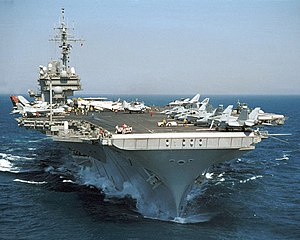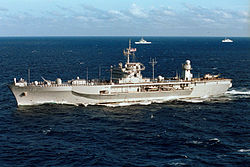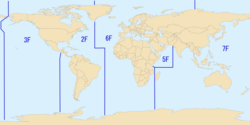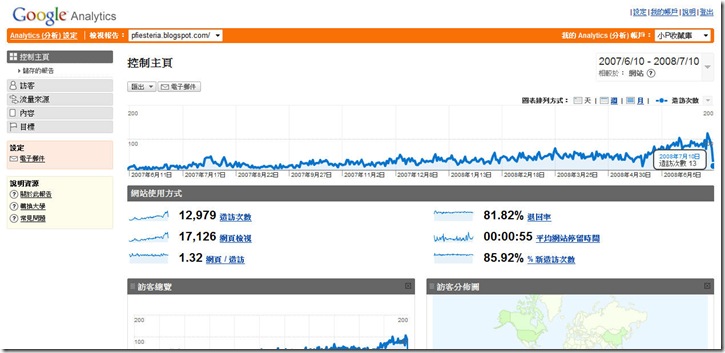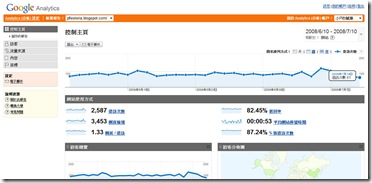United States Seventh Fleet - Wikipedia, the free encyclopediaThe Seventh Fleet is the United States Navy's permanent forward projection force based in Yokosuka, Japan, with units positioned near South Korea and Japan. It is a component fleet force under the U.S. Pacific Fleet. At present it is the largest of the forward-deployed U.S. fleets, with 50–60 ships, 350 aircraft and 60,000 Navy and Marine Corps personnel. With the support of its Task Force Commanders, it has three major assignments:
- Joint Task Force command in a natural disaster or joint military operation,
- Operational command of all naval forces in the region, and
- Defense of the Korean Peninsula.
[edit] History
The Seventh Fleet was formed on March 15, 1943 in Brisbane, Australia, during World War II. It served in the South West Pacific Area (SWPA) under General Douglas MacArthur, and the Seventh Fleet commander also served as commander of Allied naval forces in the SWPA.
Most of the ships of the Royal Australian Navy were also part of the fleet during 1943–45. The Seventh Fleet formed a large part of the Allied forces at the Battle of Leyte Gulf, October 1944, which is often said to have been the largest naval battle in history. After the end of the war, the 7th Fleet relocated to Japan.
After the war, on January 1, 1947, the Fleet's name was changed to Naval Forces Western Pacific. On August 19, 1949, just prior to the outbreak of the Korean War, the force was designated as United States Seventh Task Fleet. On February 11, 1950 the force assumed the name United States Seventh Fleet, which it holds today.[2]
Seventh Fleet units participated in every major operation of the Korean War. The first Navy jet aircraft used in combat was launched from a Task Force 77 aircraft carrier on July 3, 1950. The landings at Inchon, Korea were conducted by Seventh Fleet amphibious ships. The battleships Iowa, New Jersey, Missouri and Wisconsin all served as flagships for Commander, U.S. Seventh Fleet during the Korean War.
Over the next decade the Seventh Fleet responded to numerous crisis situations including contingency operations conducted in Laos in 1959 and Thailand in 1962.
During the Vietnam War, Seventh Fleet engaged in combat operations against enemy forces through attack carrier air strikes, naval gunfire support, amphibious operations, patrol and reconnaissance operations and mine warfare. After the 1973 cease-fire, the Fleet conducted mine countermeasure operations in the coastal waterways of North Vietnam. Two years later, ships and aircraft of the Fleet evacuated thousands of US citizens and refugees from South Vietnam and Cambodia as those countries fell to opposing forces.
A carrier task force of the Seventh Fleet, Task Force 74, made a U.S. incursion into the Bay of Bengal at the height of the Indo-Pakistani War of 1971 in December 1971.[1] Task Force 74 comprised the nuclear-armed carrier USS Enterprise, the amphibious assault carrier USS Tripoli, four destroyers, three guided-missile escorts, and a nuclear-powered attack submarine.[2] On December 15, a day before the surrender of East Pakistan, the task force entered the Bay of Bengal, at a distance of some 1,760 km from Dhaka. Although the objective of this naval deployment appeared to be an attempt to assist Pakistan, the nature and extent of this assistance remained unclear.
Since Vietnam, the Seventh Fleet has participated in a joint/combined exercise called Team Spirit, conducted with the Republic of Korea armed forces. With capability to respond to any contingency, Fleet operations are credited with maintaining security during the Asian Games of 1986 and the Seoul Olympics of 1988. During 1989, Seventh Fleet units participated in a variety of exercises called PACEX, the largest peacetime exercises since World War II.
In response to the August 2, 1990 Iraqi invasion of Kuwait, President George H. W. Bush ordered Commander, U.S. Seventh Fleet to assume additional responsibilities as Commander, U.S. Naval Forces Central Command (COMUSNAVCENT). The Fleet Commander departed Yokosuka, Japan immediately, heading for the Persian Gulf, and joined the remainder of his staff aboard the flagship USS Blue Ridge on September 1, 1990. During Operation Desert Shield/Storm, COMUSNAVCENT exercised command and control of the largest US Navy armada since World War II. At the peak of combat operations, over 130 US Navy ships joined more than 50 allied ships from a multi-national force to conduct maritime intercept operations, minesweeping and combat strike operations against enemy forces in Iraq and Kuwait. COMUSNAVCENT included six aircraft carrier battle groups, two battleships, two hospital ships, 31 amphibious assault ships, four minesweeping vessels and numerous combatants in support of allied air and ground forces. After a decisive allied victory in the Persian Gulf War, Commander US Seventh Fleet relinquished control of COMUSNAVCENT to Commander, Middle East Force on April 24, 1991 and returned to Yokosuka, Japan to continue the duties of Commander, US Seventh Fleet.
Following the end of the Cold War, the two major military scenarios in which the Seventh Fleet would be used would be in case of conflict in Korea or a conflict between People's Republic of China and Taiwan (Republic of China) in the Taiwan Strait.
[edit] Operations
Of the 50–60 ships typically assigned to Seventh Fleet, 18 operate from U.S. facilities in Japan and Guam. These forward-deployed units represent the heart of Seventh Fleet. The 18 permanently forward-deployed ships of the US 7th Fleet are the centerpieces of American forward presence in Asia. They are 17 steaming days closer to locations in Asia than their counterparts based in the continental United States. It would take three to five times the number of rotationally-based ships in the United States to equal the same presence and crisis response capability as these 18 forward deployed ships. On any given day, about 50 percent of Seventh Fleet forces are deployed at sea throughout the area of responsibility. The Seventh Fleet Command Ship is the USS Blue Ridge, forward deployed to Yokosuka, Japan. In 2004, Blue Ridge entered dry dock and command responsibility was transferred temporarily to USS Coronado (AGF-11). Blue Ridge returned to duty 27 September 2004.
[edit] Fleet Organization
For operational and administrative purposes the United States Seventh Fleet, as with other numbered fleets, is organized into several specialized task forces.
- Task Force 70 — TF 70 the Battle Force of 7th Fleet and is actually made up of two distinct components: Surface Combatant Force 7th Fleet, composed of cruisers and destroyers, and Carrier Strike Force 7th Fleet, made up of at least one aircraft carrier and its embarked air wing. The Battle Force is currently centered around the carrier USS Kitty Hawk (CV-63) and Carrier Air Wing 5 (CVW-5).
- Task Force 71 — TF 71 includes all Naval Special Warfare (NSW) units and Explosive Ordnance Disposal Mobile Units (EODMU) assigned to 7th Fleet. It is based in Guam.
- Task Force 72 — TF 72 is the Patrol-Reconnaissance Force of the Seventh Fleet. It is mainly composed of anti-submarine warfare (ASW) aircraft and maritime airborne surveillance platforms such as P-3 Orion and EP-3 reconnaissance planes operating on land bases. Toward the end of the Korean War, Commander Task Force Seventy-Two transferred his flag to USS Pine Island on 7 March and detachments of VP-42 also left USS Salisbury Sound for that seaplane tender. That same day Task Force Seventy-Two was established as the Formosa Patrol Force under Rear Admiral Williamson in Pine Island.[3]
- Task Force 73 — 7th Fleet's Logistics Force composed of supply ships and other fleet support vessels.
- Task Force 74 — TF 74 was the designation used for the Enterprise's battle group in 1971. Today, it is the Fleet Submarine Force responsible for planning and coordinating submarine operations within 7th Fleet's area of operations.
- Task Force 75 — Designation of the Surface Combatant Force assigned to Seventh Fleet responsible for the cruisers and destroyers that are not assigned as escorts to aircraft carriers.
- Task Force 76 — Amphibious Assault task force mainly responsible for supporting Marine landing operations. It is composed of units capable of delivering ship-to-shore assault troops, such as Tarawa-class and Wasp-class amphibious assault ships, and landing craft. Rear Admiral Carol Pottenger current commands TF 76.[4]
- Task Force 77 — 7th Fleet Mine Warfare Force composed of mine countermeasure, mine hunter, and mine control ships as well as mine countermeasure helicopters (MH-53). This task force is only activated during specific combat operations and is filled by the Commander of Mine Warfare Command.
- Task Force 79 — The Marine expeditionary unit or Landing Force assigned to the fleet, consisting of at least a reinforced Marine battalion and its equipment. This unit is separate from the Marine Expeditionary Unit (MEU) normally embarked in USS ESSEX Amphibious Readiness Group (ARG). Marine units serving in 7th Fleet are normally drawn from III Marine Expeditionary Force (MEF) based in Okinawa, Japan.
[edit] Forward-deployed Seventh Fleet ships
[edit] Fleet Commanders
[edit] External links and references
- ^ http://www.ciaonet.org/olj/sa/sa_98ror01.html
- ^ USS Enterprise, the destroyers USS Waddell, USS Decatur, USS King and USS Parsons, plus the USS Tripoli with the destroyers USS McKean and USS Orleck, and the supply ships USS Wichita and USS Haleaka, and the attack submarine USS Gurnard
- ^ US Navy Historical Center, Korean War Naval Chronology, January-April 1953, accessed March 2008
- ^ United States Navy [1], accessed 18 May 2008
| [hide] United States Navy Fleets |
|
| Active | |
|
| Historic | |

